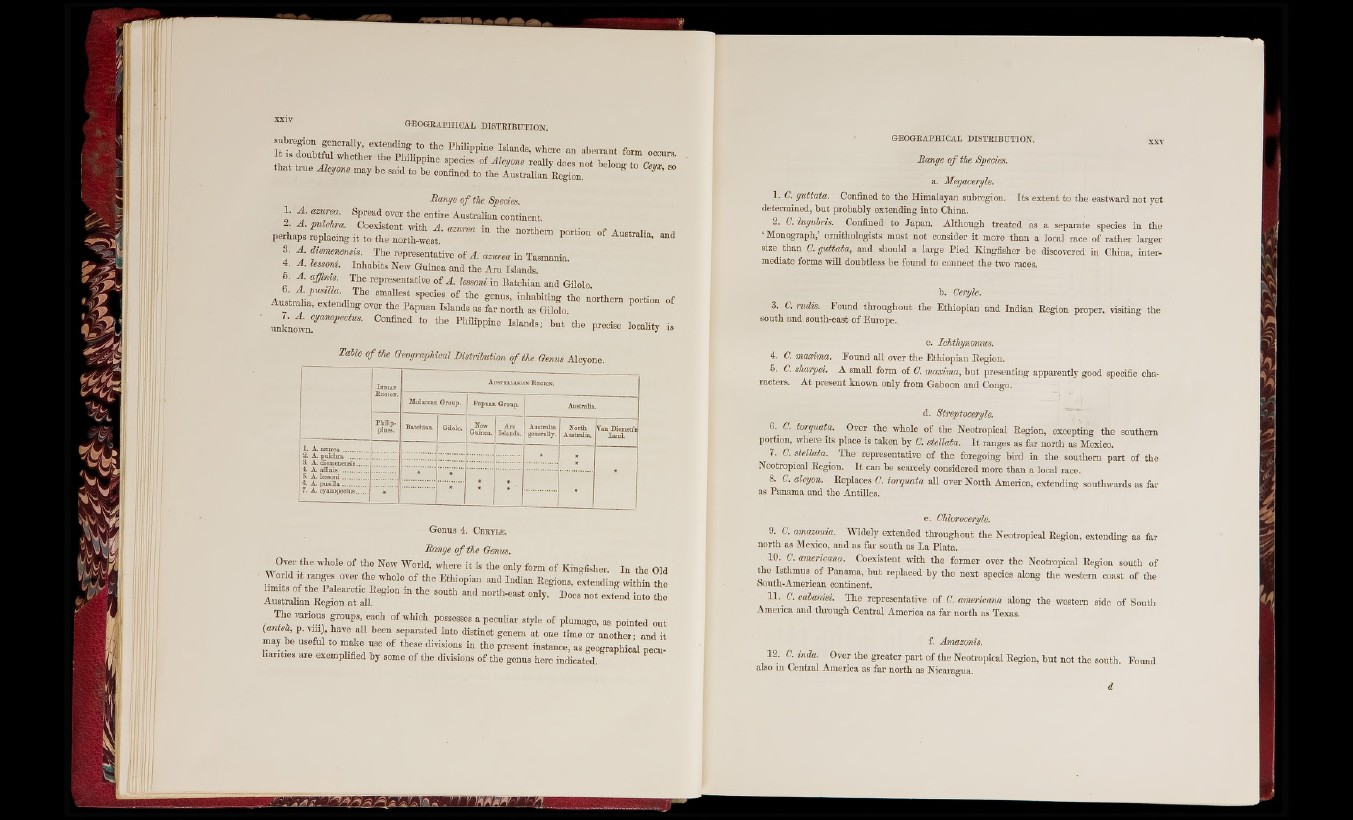
g e o g r a p h ic a l d is t r ib u t io n
Range o f the Species.
1. A azurea. Spread over th e entii-e Australian continent.
'■ p— -
3. A dzemenmsis. The representative o i A . azurea in Tasmania.
4. A Ussom. In h ab its New Guinea and th e A m Islands.
&. A . affims. The representative o f A . lessoni in Batchian and Gilolo
p o - Of
u n ta ow n :” ' “ *- » " ‘ ' ‘ho P - i s e locality is
Table o f the Oeograpliioal Distribution o f the Genus Alcyone.
I ndian I Australasi.a.v REaioN.
iABGION.
MoluocasI Group. Papuan Group. Australia.
Philip.
pines. i Batchian. Gilolo. Now
Guinea.
Aru
Islands.
Australia
generally.
North
Australia.
Tan Diemen’s
Land.
1. A. azureji __
2. A. pulchra . .
S. A. diemenensis.......
4. A. afHnis ................
5. A. le sso n i.............
6. A. p usiOa.............. i l l i Z '
• '
* •
•
G e n u s 4 . C k k y le .
Bange o f the Genus.
Over th e whole o f th e New World, where it is th e only form o f Kingfisher. In the Old
World E ™>ges over th e whole o f th e Ethiopian and In d ian Eegions, extending within the
limits o f th e 1 alearctic Eegion in th e south and north-east only. Does not extend into the
Au stralian Region a t all.
The various groups each o f which possesses a peculiar style of plumage, as pointed out
(antea, p. viii , have a ll been separated into distinct genera a t one time or an o th e r- and it
may be useful to make use o f these divisions in the present instance, as geographical pecu-
lia n tie s a re exemplified by some o f tbe divisions o f th e genus here indicated.
1. C. guttata. Confined to the Himalayan subregion. Its ex ten t to the eastward n o t yet
determined, b u t probably extending into China.
2. C.'luguhris. Confined to Japan. Although treated as a separate species in the
‘ M onograph,’ ornithologists must not consider i t more th an a local race o f rath e r larger
size th an C. guttata, and should a large Pied Kingfisher be discovered in China, in te rmediate
forms will doubtless be found to connect the two races.
b. Ceryle.
3. C. rudis. Found th ro u g h o u t the Ethiopian and Indian
south and south-east o f Eui'ope.
Region proper, visiting the
c. Ichthynomus.
4. C. maxima. Found all over tbe Ethiopian Region.
A small form o f C. maxima, b u t presenting apparently 6. 0. good specific characters.
A t present known only from Gaboon and Congo.
d.
6. C. torquata. Over the whole o f th e Neotropical Eegion, excepting th e southern
portion, where its place is taken by C. stellata. I t ranges as far n o rth as Mexico.
7. C. stelUta.^ The representative o f th e foregoing bii-d in th e southern p a rt o f tbe
Neotropical Eegion. I t can be scarcely considered more th an a local race.
8. C. alcyon. Eeplaces C. torquata all over N o rth America, extending southwards as tar
as Panama and the Antilles.
e. Chloroceryle.
9. C. amazonia. AVidely extended throughout the Neotropical Eegion, extending as far
n o rth as Mexico, and as far south as La Plata.
10. C. amencana. Coexistent with th e former over th e Neotropical Eegion south of
the Isthmus of Panama, b u t replaced by the n ex t species along the western coast o f the
Soutb-American continent.
11. C. cabanisi. The representative o f C. amencana along the western side o f South
America and through Central America as fai- n o rth as Texas.
f. Amazonis.
12. C. inda. Over th e g reater pai-t o f th e N eotropical Eegion, b u t n o t th e south. Found
also in Central AAmmoevrticci»a aQOs f-fariri. Vn..o-Xr..4tVh, .a.. s- ANTiic-_a_ra__g_u_a.